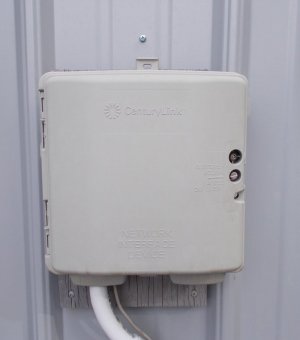
This concerns most area with computer technology.
Starting with....
Structured wiring/cabling is a better way to run your network at home or work. This can include the old telephone service, also known as "POTS", "copper" and/or analog. A common desk phone can be single or multi-line type. The latter is also called a "keyset" in the old mechanical days of 1A2 key switching in the 1960's.
Your dial tome provider (DTP) is known as the local telephone company. In the Pacific NorthWest the largest one as been Century Link formally, NW Bell. Service is routed to the nearest Central Office (CO), then via wire line (copper) to your home. This is done with a pair of copper wires hence, two conductors. Each wire has a name and purpose. The first one is "Tip" and normally a green wiring in RJ-11 jacks and white-blue in structured or demarcation devices. The second one is "Ring" and normally is a red wire in RJ-11 jacks and blue-white in the other area.
In a standby state there is "station battery" on the pair. Tip is ground return and Ring is the battery voltage at a -48. Therefore, telephone systems are a positive ground system, using negative voltage for operation. In some cases the cable installation has the pair reversed. While an annoyance, this won't cause a problem with the operation. This pair also has several types of signaling used on it. The most common ones will be discussed here.
When you wish to make an outgoing call, you lift your phone's handset which causes a DC load on the pair, drawing around 20 mill-amp (20ma) of current. This action signals the CO into giving you a dial tone. Dial tone is a dual-tone frequency of 350 and 440 Hz. When you dial (either rotary or push button) this sends the information to the CO. The CO in turn, routes the call to the number/station you dialed. When the far end answers their phone signals the CO to complete the connection and allow you and the far end to talk. When you are done and place the handset down you break the current loop and terminate the call.
When a far end wishes to call you (incoming call) they do the same as discribed above. Then the CO routes the call to your station/phone and sends "ringdown" voltage to your phone. This is typically 105 volts, AC at 30Hz. When you answer the call your phone loads the line to signal the CO to connect both ends together as before.
Tip: During the ringing if you answer the call sometimes you will hear a laud buzzing. That's the AC ring voltage. Normally, the "ring trip" function in the CO avoids this condition.
Your dial tone provider (Tel Co) divides up the responsibility of maintenance to your phone line. Normally, there is a "network" interface box nearby your home, on the outside wall. From the CO to this "box" is Tel Co's responsibility (and cost) for repairs and other maintenance. From the box to the inside wiring of your home is your responsibility. Therefore, if Tel Co finds a repair problem is on the "customer" side (you) (and your wiring) you will be charged for that service call. As of 2018 that's about $95 to start with.
To help avoid this charge you can "test" your line to find which direction the problem may be. The Tel Co sometimes calls this the "trouble" direction or area. Inside the network (demarcation point) box is a RJ-11 plug and jack for this purpose.

Using the flat blade screw, loosen that and press on the side door clip to swing it open as shown here. For this image was already a line cord pugging into the jack. This won't be the case for you, yet.
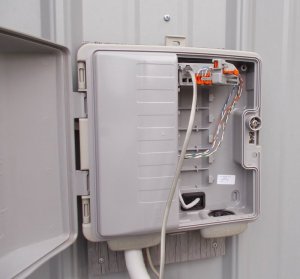
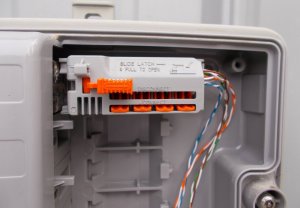
Next, swing open the RJ-11 plug. Now you can plug in a regular phone with a modular line cord. If you get dial tone, can place and receive calls then mostly likely the problem is on your responsibly side. If you get nothing (no dial tone, etc.) then most likely the problem is on the TelCos responsibility side.
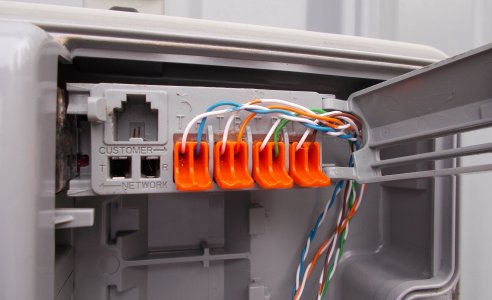
There is one little issue that can occur. Notice this image shows a pair of contact that the swing-out plug had. (you can enlarge this image by clicking on it). Once side (up and down) of the contacts is from the CO (called "network" in the image, while the other side is to the "customer" (your equipment), you. Sometimes the plug and it's contacts can be intermittent. If this is the case you can exercise them a few times. Otherwise, the Tel Co may try to pull a "fast one" and blame you for the problem thus, charging you for the service call. Note: For Washington State the normal number to call for Tel Co service is (800) 244-1111. And yes, you will have to put up with a silly computerize voice and help center.
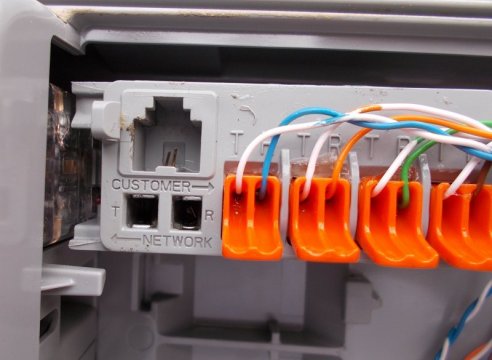
This may be copied in complete form only for non-profit purposes, such as for the knowledge for the Amateur Radio Service, with AK2O credited as designer. For other arrangements please contact the author.
Copy write: AK2O 2013
![[SRG home Direction]](images/srghome.gif)